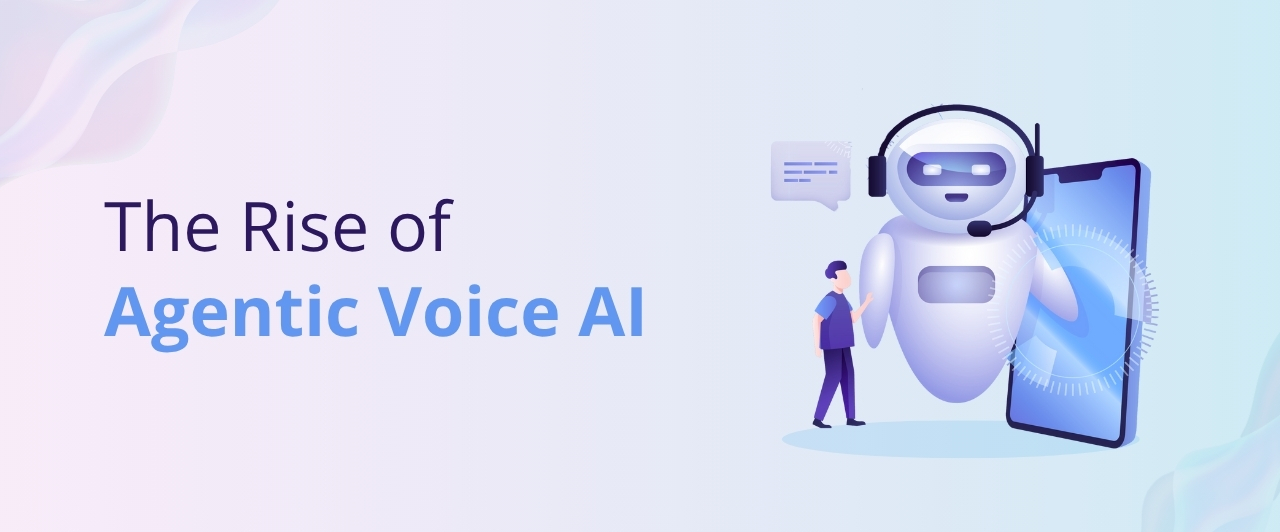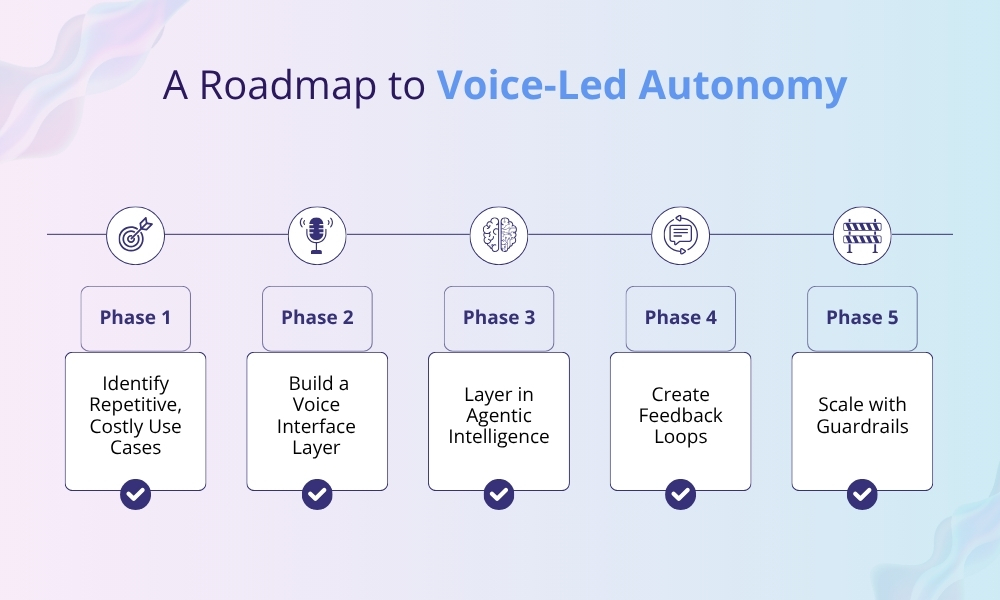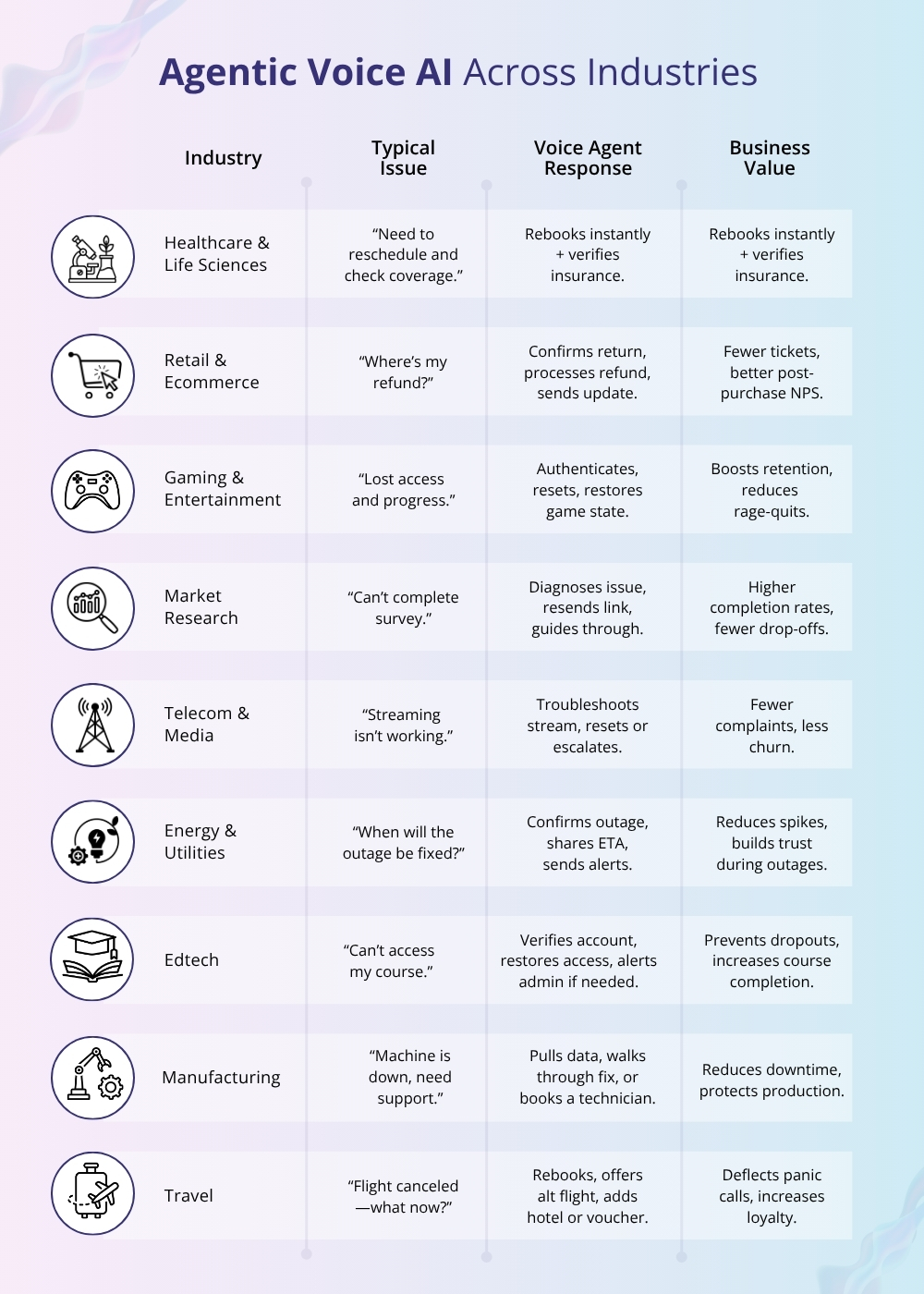- Voice as interface: natural, frictionless, human.
- Agentic AI: systems that don’t wait to be told what to do they figure it out.



Let’s face it! Most support interactions still suck. You tap through menus, shout “representative” into the void, or chat with a bot that politely doesn’t know what to do with your problem.
Now imagine this instead:
You speak. Just naturally. No awkward phrasing. The system picks up on the issue, knows who you are, pulls the right data, handles the fix, and confirms—all in one smooth exchange. It doesn’t just respond; it acts. You hang up thinking, “Wait… that was actually helpful?”
This isn’t sci-fi. It’s already happening in pockets. What’s making it possible is the convergence of two powerful forces:
We’re moving from reactive bots to autonomous agents that can navigate messy realities: delays, refunds, reschedules, personalized solutions. And voice is turning out to be the gateway that makes it all feel seamless.
This blog unpacks what agentic AI actually is (not the buzzword version), how voice unlocks new UX possibilities, and why companies that combine the two are quietly leaping ahead in customer experience. If you’re building, leading, or rethinking how your brand talks to its users—this is for you.
Let’s clear something up: agentic AI isn’t just another smarter chatbot. It’s not your average assistant that waits for instructions and regurgitates answers. It’s not ChatGPT with a polite greeting.
Agentic AI is a shift in role, from responder to operator.
At its core, it refers to AI systems that have agency: they perceive context, make decisions, and take action toward a goal, often without waiting for a human to drive the process. Think of it as the difference between an intern waiting for instructions and a seasoned ops manager who sees a problem, pulls data, resolves it, and lets you know it’s handled.
That’s the leap. And it’s not theoretical anymore.
Agentic AI systems are already being deployed to:
What makes this shift powerful isn’t just autonomy-it’s goal-oriented autonomy. These systems don’t just “do a task.” They understand what the end is supposed to look like (a resolved complaint, a retained customer, an answered ticket) and navigate toward it dynamically.
To make this crystal clear, here’s what agentic AI is not:
| ❌ Not This | ✅ But This |
|---|---|
| A rules-based bot that follows a tree | An adaptive agent that makes real-time choices |
| A generative model spitting facts | A planner that acts, revises, and escalates when needed |
| A passive tool waiting for input | A system with goals, memory, and initiative |
Customer service isn’t just about answers, it’s about resolution. Most legacy systems aren’t built for that. They transfer, escalate, or deflect. Even most modern chatbots just redirect you to a help article.
Agentic AI changes the default from “assist when asked” to “solve when possible.”
It looks at:
...and then makes a decision. Ideally, a good one.
And here’s the kicker: when this is paired with voice, the most natural, human input channel we have—it doesn’t just work. It feels effortless.
If agentic AI is the brain, voice is the vibe. It’s what takes smart systems and gives them presence immediacy, emotion, and tone.
We’ve spent the last decade teaching people how to talk to machines. Press 3. Say “billing.” Type “cancel subscription.”
Voice flips that. Now machines are learning how to talk to us—on our terms.
And that matters, especially in service contexts where frustration, urgency, and nuance are always in the mix.
Here’s why voice isn’t just a flashy interface, it’s the most human way to interact with AI:
But more importantly: voice feels human. And when AI can not only understand but respond in kind fluidly, empathetically, intelligently you get something far more than a “support channel.” You get trust.
Voice lets users express messy, multi-step problems in a single stream:
“Hey, I was charged twice for the same item last week I already returned one of them, but I haven’t seen the refund, and I want to make sure my subscription isn’t paused.”
No chatbot flow handles that cleanly.
But an agentic voice AI can:
Voice doesn’t just make things work faster it makes them feel more natural. That’s a game-changer for customer loyalty.
We’ve moved from:
And when that promise is backed by real autonomy not just clever replies it stops being a gimmick and becomes the gold standard.
Let’s say you're a frequent flyer. You land in a different city, check your phone, and… your connecting flight just got canceled.
You're tired. Frustrated. You don’t want to fight through an app or sit on hold for 40 minutes. So, you tap to call support.
Here’s what happens next and how agentic voice AI handles it like a pro:
You (spoken):
“Hi, I just landed in Denver, and I got a message that my connection to San Diego is canceled. What now?”
What Happens Behind the Scenes
The Agent Responds (in less than 6 seconds)
“Hi Alex. I’ve confirmed your connection was canceled due to weather. I’ve rebooked you on the next available flight, leaving at 7:45 p.m., with an automatic upgrade to business class.
I’ve also arranged a meal voucher, and if you’d prefer a hotel instead, just say the word, I can book that too.”
No Hold Music. No App Hopping. No Human Intervention.
That’s what agentic AI does: it doesn’t offer you choices, it executes the best one based on rules, context, and care. And with voice, it feels natural, human, even reassuring.
This isn’t a chatbot offering a link. It’s an autonomous agent that:
Now imagine this not just for airlines, but for:
Let’s be clear: you don’t need a moonshot budget or a secret AI lab to get started. But you do need to be strategic.
Building voice-led, agentic AI into your customer experience doesn’t happen with a single platform or plug-in. It’s a stack a smart combination of intelligence, automation, and orchestration.
Here’s how forward-thinking teams are getting it done:

Start small, but smart. Don’t automate the weird edge cases. Focus on:
You need a natural front-end. Skip the robotic menus.
Now it gets interesting. This is where the “smart” happens.
You need a way to know what’s working, and what’s not.
As you expand:
Agentic AI + voice isn't just a shiny concept for innovation decks. It’s in the wild solving actual problems across high-pressure, high-volume industries. Here’s how it’s playing out in four spaces where experience matters and speed is survival:
The problem:
Healthcare support is notoriously complex. Booking appointments, verifying insurance, refilling prescriptions it’s often wrapped in jargon, compliance layers, and long wait times.
The shift:
Agentic voice agents can now:
Why it works:
Voice is personal and direct—ideal for contexts where patients may be anxious, impaired, or overwhelmed.
The problem:
Most post-purchase experiences are clunky. Lost packages, partial refunds, wrong items—support gets flooded, and scripted bots offer copy-paste apologies.
The shift:
Agentic voice systems in ecommerce can now:
Why it works:
Voice is faster than chat and feels like a real concierge—not a flowchart.
The problem:
Gamers hit issues in real-time: login problems, banned accounts, failed purchases, lag complaints. They want answers now, not 72 hours later.
The shift:
Voice agents for gaming support can:
Why it works:
Gamers don’t want to fill out a ticket—they want to say “fix it” and get back in the game.
The problem:
Flight changes, cancellations, rebookings, baggage issues—travel is built on moving parts, and when they break, people panic.
The shift:
Agentic voice support now handles:
Why it works:
Travelers are in motion. Voice is hands-free, fast, and feels like control in chaos.

Takeaway
Across industries, the formula is the same:
High-volume problem + decision-ready data + voice interface = zero-friction resolution.
Agentic AI isn’t just replacing agents, it’s redefining what resolution even means.
Let’s skip the empty buzzwords. Here’s what businesses really get when they do voice-led, agentic AI right and why users finally stick around when they do.
Let’s start with the obvious: human agents are overused. They're stuck doing things machines could’ve handled years ago like chasing refunds, rescheduling appointments, rebooking flights. That’s not just inefficient. It’s expensive.
Agentic AI flips that equation.
It resolves repetitive issues—start to finish—without handing them off to a person. That means fewer tickets, less burnout, and far better use of your real team’s time.
And because these agents are goal-oriented, not script-bound, they don’t just deflect. They complete.
What changes:
Speed isn’t just a metric. It’s a loyalty engine.
When a customer gets what they need instantly, that becomes brand memory. It's not “support” anymore—it’s confidence. One voice input. One intelligent outcome. That’s the new baseline.
Agentic voice AI doesn’t wait to be told what to do—it already knows the options, checks the rules, makes the right call, and explains it clearly. In the time it takes a human agent to say, “Let me check on that,” it’s already resolved.
What changes:
Here’s the part most teams miss: Every voice interaction becomes a data-rich feedback loop.
These agents don’t just respond, they learn. They surface patterns, detect new failure points, and optimize over time. Your support org starts generating product insights you can actually use.
And because voice captures emotion, urgency, and hesitation in real-time—you’re now learning from how people say things, not just what they type. That's gold for CX, product, and ops teams.
What changes:
Voice-led AI today is impressive but the next wave? It won’t just respond or resolve. It will adapt.
We’re stepping into a future where agents don’t just execute, they anticipate. Where voice doesn’t just understand your words, it picks up your frustration before you even finish the sentence. And where every interaction flows across systems, channels, and senses—just like talking to a real assistant who knows your world.
Here’s what’s coming fast:
Voice agents that listen for tone, urgency, and silence—not just words. They’ll slow down, soften, escalate, just like a good human would.
Say it with your voice, see it in your app. Visual confirmations, maps, receipts, options—all surfaced in sync. One interaction, many dimensions.
AI that moves between calendars, CRMs, logistics tools, and user data like an invisible operator that knows what to do and where to go.
This isn’t a distant vision.
It’s the near-future roadmap and the companies that embrace it early?
They won’t just be more efficient.
They’ll feel effortless to do business with.
Voice isn’t just a feature, and agentic AI isn’t just another tool in the tech stack. Together, they’re forming the backbone of a new kind of experience—one where customers don’t wait, repeat themselves, or wonder if someone’s actually going to fix the issue. They speak, the system listens, and the problem gets solved.
This shift isn’t just about automating support. It’s about redesigning how service happens. We’re moving from chatbots that follow scripts to autonomous agents that understand goals. From support as a siloed channel to support as a distributed intelligence layer that touches everything—logistics, billing, CRM, loyalty.
That layer isn’t reactive. It’s proactive. Personal. Persistent.
And the companies that embrace this shift early—the ones who invest in voice-first, agentic experiences that truly deliver—won’t just reduce ticket volume or speed up resolution times. They’ll build something much harder to replicate: trust.
If you’re exploring how voice and agentic AI can transform your customer experience, we’re here to help you make it real.
From identifying your best starting use case to deploying production-ready systems that listen, decide, and resolve, we partner with teams who are ready to lead, not lag.
Let’s design the kind of support your customers will actually remember.
Reach out to start your pilot, request a walkthrough, or talk through what’s possible.
Agentic AI refers to systems that can make decisions and take action autonomously, without waiting for human input. It’s more than just responding; it’s about resolving issues in real time
Agentic AI goes beyond answering questions—it solves problems. It looks at customer data, makes decisions, and takes action, making support faster and more efficient.
Combining voice with Agentic AI makes customer support more natural and efficient, handling issues quickly while offering a more personal, empathetic experience.
Agentic AI reduces operational costs by automating repetitive tasks, speeds up issue resolution, and improves customer loyalty by delivering seamless, efficient support.
Healthcare, retail, gaming, and travel industries are just a few examples where Agentic Voice AI enhances customer service, offering fast, personalized support at scale.
Are You Prepared for Digital Transformation?
AI Development
Discover real digital transformation examples from leading brands and learn how to choose the right digital transformation company in USA..
AI Development
VT Netzwelt shares key insights from NASSCOM Agentic AI Confluence 2025 on responsible AI, autonomy, and the evolution from experimentation to execution.
AI Development
Discover the top 10 programming languages for AI development in 2025. From Python to Rust, find out which AI language is best to power your next big idea.